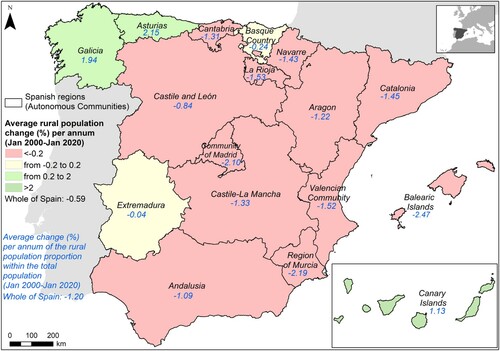 ?Mathematical formulae have been encoded as MathML and are displayed in this HTML version using MathJax in order to improve their display. Uncheck the box to turn MathJax off. This feature requires Javascript. Click on a formula to zoom.
?Mathematical formulae have been encoded as MathML and are displayed in this HTML version using MathJax in order to improve their display. Uncheck the box to turn MathJax off. This feature requires Javascript. Click on a formula to zoom.ABSTRACT
Since the first months of 2020, the Covid-19 pandemic has driven social distancing measures in many countries, which have made it potentially more attractive to reside in less populated areas. This paper visualizes whether the registered populations in municipalities with fewer than 2000 inhabitants in Spanish regions have changed during 2020 in a different way than previous years. The per cent variation of the rural population is measured, as well as the proportion of the rural population over the total population, in two periods: January 2000–January 2020 and during 2020. The results show an increase in the rural population in 13 of the 17 Spanish regions, and an increase in the proportion in 14 regions during 2020, in contrast to the declining trends prevailing in previous years.
In the context of the Covid-19 pandemic, social distancing measures have led to an increase in the residential attractiveness of rural areas and a rise in teleworking (Cotella & Vitale-Brovarone, Citation2020; Nathan & Overman, Citation2020). There is still little research on whether the pandemic is leading to an increase in the rural population. The objective of this study is to show how the pandemic affected the rural population’s volume and proportion in Spain during 2020. The areas composed of municipalities with fewer than 2000 inhabitants were classified as rural. These areas are characterized in general terms in Spain by their high ageing index (Pérez-Díaz et al., Citation2020) and their population loss on a national scale since the beginning of the 20th century (Zoido-Naranjo & Arroyo-Pérez, Citation2003).
Population data were obtained from the Spanish Continuous Municipal Register, including the provisional data of 1 January 2021 provided by the Spanish Statistical Institute (INE) (Citation2021). The period before the pandemic was delimited from January 2000 to January 2020, to be compared with the period January 2020–January 2021. In and we quantified in the respective periods (i) the rural population per cent change per annum and (ii) the per cent change per annum of the rural population’s proportion within the total population, by using the following expression:
(1)
(1) where for (i): x is the rural population at the beginning of each period; y is the rural population at the end; and n is the number of years that each period contains; and (ii): x is the rural population percentage within the total population at the beginning of each period; and y is the rural population weight at the end.
Figure 1. Average rural population per cent change per annum in Spanish regions from January 2000 to January 2020, further indicating the average per cent change per annum of the rural population proportion within the total population.

Figure 2. Rural population per cent change in Spanish regions during 2020, further indicating the per cent change of the rural population proportion within the total population.

The results show an increase in the rural population in 13 of the 17 Spanish regions, as well as an increase in the proportion of the rural population over the total population in 14 regions during 2020, in contrast to the decreasing trends predominant in the prior period. Therefore, the social-distancing measures implemented as a result of the Covid-19 pandemic have caused an increase in the residential attractiveness of Spanish rural areas, composed of municipalities with fewer than 2000 inhabitants, during 2020.
DISCLOSURE STATEMENT
No potential conflict of interest was reported by the author.
REFERENCES
- Cotella, G., & Vitale-Brovarone, E. (2020). Rethinking urbanisation after COVID-19. What role for the EU cohesion policy? Town Planning Review, 92(3), 411–418. https://doi.org/https://doi.org/10.3828/tpr.2020.54
- INE. (2021). Continuous register statistics. https://www.ine.es/uc/Ut4Z2lyd
- Nathan, M., & Overman, H. (2020). Will coronavirus cause a big city exodus? Environment and Planning B: Urban Analytics and City Science, 47(9), 1537–1542. https://doi.org/https://doi.org/10.1177/2399808320971910
- Pérez-Díaz, J., Abellán-García, A., Aceituno-Nieto, P., & Ramiro-Fariñas, D. (2020). Un perfil de las personas mayores en España, 2020. Informes Envejecimiento en red, 25. http://envejecimiento.csic.es/documentos/documentos/enred-indicadoresbasicos2020.pdf
- Zoido-Naranjo, F., & Arroyo-Pérez, A. (2003). La población de España. In A. Arroyo-Pérez (Ed.), Tendencias demográficas durante el siglo XX en España (pp. 17–75). INE. http://hdl.handle.net/11441/64920
